Error processing SSI file
|
Mission Log Aug. 13, 2008
R/V Fulmar
Lisa Etherington, Research Coordinator
Cordell Bank National Marine Sanctuary
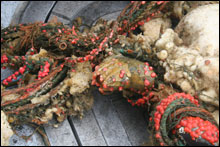 |
| Multiple types of fishing gear entangled together and covered with a variety of invertebrates, including cup corals, sponges, large barnacles, brittle stars and anemones. (Photo: Jennifer Renzullo/Cordell Bank National Marine Sanctuary) |
The main cruise objective of testing methods of removing derelict fishing gear from the seafloor provided us the opportunity to use the extracted gear and attached animals for a variety of research and educational purposes. During the cruise, we pulled up a variety of different fishing gear types that were covered in an abundance and diversity of invertebrates.
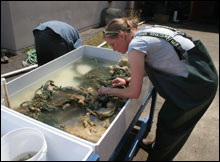 |
| Pieces of fishing gear with marine invertebrates were sorted in seawater tanks and representative animals were photographed and preserved. (Photo: Dale Roberts/Cordell Bank National Marine Sanctuary) |
This is the first opportunity that we have had to look at the animals of Cordell Bank up close and in person, so this was a pretty exciting event for us! Our only other views of these animals have been through the porthole of a submersible or through the pictures of the early SCUBA diver explorers from ‘Cordell Expeditions ’ who visited the reef top of Cordell Bank in the 1980s. So, we decided to make the most of our opportunity. Luckily, we were able to use the seawater facilities at the Bodega Marine Laboratory (University of California-Davis ’ who visited the reef top of Cordell Bank in the 1980s. So, we decided to make the most of our opportunity. Luckily, we were able to use the seawater facilities at the Bodega Marine Laboratory (University of California-Davis ) for holding and sorting through the gear and specimens. ) for holding and sorting through the gear and specimens.
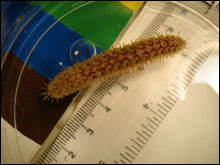 |
| Scale worm collected from derelict fishing gear on Cordell Bank that was preserved for identification. (Photo: Oakland Museum Of California/Lindsay Dixon) |
We decided that we should collect and preserve a representative sample of every species that we found on the derelict fishing gear, so that we could identify the organisms and generate a list of species found on Cordell Bank. Often it is difficult to identify organisms with photos alone, so having animals in the lab provides us with an opportunity to give these animals their proper scientific names, rather than vaguely describing them based on their general characteristics (for example, ‘vase sponge’). We are working with partners at California Academy of Sciences who have the expertise in identifying animals from the California marine environment. who have the expertise in identifying animals from the California marine environment.
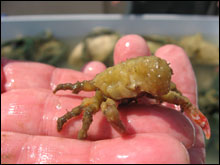 |
| Crab with encrusting invertebrates on its carapace. (Photo: Oakland Museum of California/Lindsay Dixon) |
Identifying the species we found on the gear will help us to understand how the Cordell Bank ecosystem is similar to as well as different from other rocky habitats within the California Current region. It also allows us to screen for the possibility of any invasive species that have found their way to Cordell Bank and could cause harm to the native species on Cordell Bank.
Seeing these animals that live deep in the ocean alive in a tank was truly fascinating, and we wanted to make sure that others could share in this amazement.
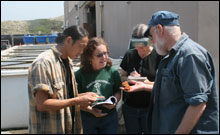 |
| Oakland Museum of California staff examine specimens of species that will be included in the upcoming Cordell Bank exhibit. (Photo: Dale Roberts/Cordell Bank National Marine Sanctuary) |
Therefore, we worked with multiple partners in the area to provide animals from Cordell Bank for different aquarium displays, including those within California Academy of Sciences, Bodega Marine Laboratory, and the Gulf of the Farallones Visitor Center . Some groups decided to display not only the animals, but also the derelict fishing gear in their tanks to raise awareness of the impacts of marine debris in the ocean environment. Images of fishing gear and representative samples of the gear will also be used by Sanctuary staff for various outreach activities. . Some groups decided to display not only the animals, but also the derelict fishing gear in their tanks to raise awareness of the impacts of marine debris in the ocean environment. Images of fishing gear and representative samples of the gear will also be used by Sanctuary staff for various outreach activities.
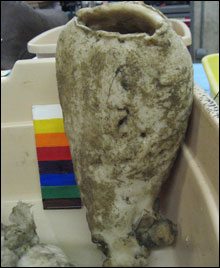 |
| Large sponge that was growing on derelict fishing gear on Cordell Bank, which will be freeze-dried and displayed at the Oakland Museum. (Photo: Oakland Museum of California/Lindsay Dixon) |
Oakland Museum of California also benefited from the collection of animals on the derelict fishing gear to help in their development of an upcoming exhibit piece on the habitats and animals of Cordell Bank. The museum staff plans to use the live animals to create models of the animals for the exhibit. They also will be experimenting with freeze-drying some animals (such as sponges) to be displayed as part of the exhibit. also benefited from the collection of animals on the derelict fishing gear to help in their development of an upcoming exhibit piece on the habitats and animals of Cordell Bank. The museum staff plans to use the live animals to create models of the animals for the exhibit. They also will be experimenting with freeze-drying some animals (such as sponges) to be displayed as part of the exhibit.
|

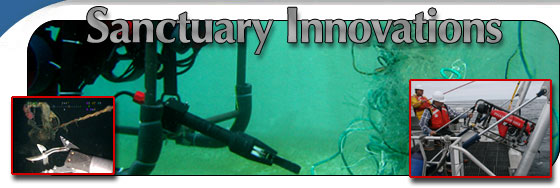
 ’ who visited the reef top of Cordell Bank in the 1980s. So, we decided to make the most of our opportunity. Luckily, we were able to use the seawater facilities at the Bodega Marine Laboratory (University of California-Davis
’ who visited the reef top of Cordell Bank in the 1980s. So, we decided to make the most of our opportunity. Luckily, we were able to use the seawater facilities at the Bodega Marine Laboratory (University of California-Davis ) for holding and sorting through the gear and specimens.
) for holding and sorting through the gear and specimens.
 who have the expertise in identifying animals from the California marine environment.
who have the expertise in identifying animals from the California marine environment.
 . Some groups decided to display not only the animals, but also the derelict fishing gear in their tanks to raise awareness of the impacts of marine debris in the ocean environment. Images of fishing gear and representative samples of the gear will also be used by Sanctuary staff for various outreach activities.
. Some groups decided to display not only the animals, but also the derelict fishing gear in their tanks to raise awareness of the impacts of marine debris in the ocean environment. Images of fishing gear and representative samples of the gear will also be used by Sanctuary staff for various outreach activities.
 also benefited from the collection of animals on the derelict fishing gear to help in their development of an upcoming exhibit piece on the habitats and animals of Cordell Bank. The museum staff plans to use the live animals to create models of the animals for the exhibit. They also will be experimenting with freeze-drying some animals (such as sponges) to be displayed as part of the exhibit.
also benefited from the collection of animals on the derelict fishing gear to help in their development of an upcoming exhibit piece on the habitats and animals of Cordell Bank. The museum staff plans to use the live animals to create models of the animals for the exhibit. They also will be experimenting with freeze-drying some animals (such as sponges) to be displayed as part of the exhibit.









